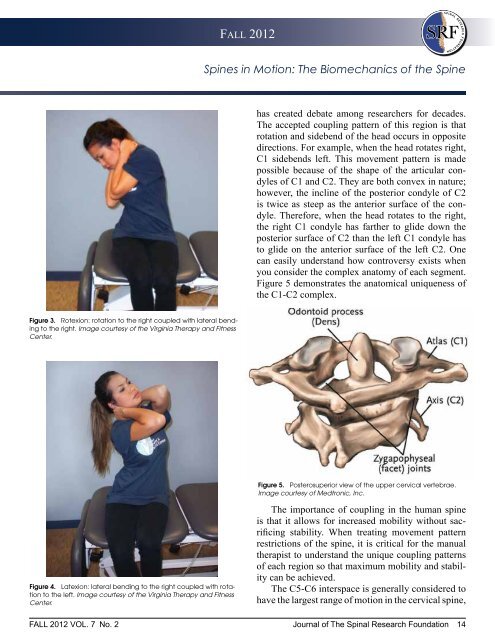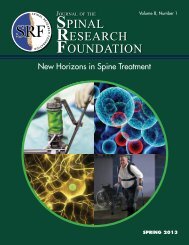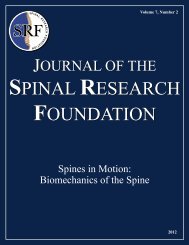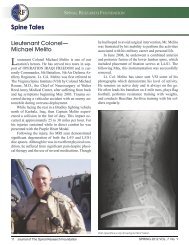Journal of - Spinal Research Foundation
Journal of - Spinal Research Foundation
Journal of - Spinal Research Foundation
You also want an ePaper? Increase the reach of your titles
YUMPU automatically turns print PDFs into web optimized ePapers that Google loves.
FALL 2012Spines in Motion: The Biomechanics <strong>of</strong> the Spinehas created debate among researchers for decades.The accepted coupling pattern <strong>of</strong> this region is thatrotation and sidebend <strong>of</strong> the head occurs in oppositedirections. For example, when the head rotates right,C1 sidebends left. This movement pattern is madepossible because <strong>of</strong> the shape <strong>of</strong> the articular condyles<strong>of</strong> C1 and C2. They are both convex in nature;however, the incline <strong>of</strong> the posterior condyle <strong>of</strong> C2is twice as steep as the anterior surface <strong>of</strong> the condyle.Therefore, when the head rotates to the right,the right C1 condyle has farther to glide down theposterior surface <strong>of</strong> C2 than the left C1 condyle hasto glide on the anterior surface <strong>of</strong> the left C2. Onecan easily understand how controversy exists whenyou consider the complex anatomy <strong>of</strong> each segment.Figure 5 demonstrates the anatomical uniqueness <strong>of</strong>the C1-C2 complex.Figure 3. Rotexion: rotation to the right coupled with lateral bendingto the right. Image courtesy <strong>of</strong> the Virginia Therapy and FitnessCenter.Figure 5. Posterosuperior view <strong>of</strong> the upper cervical vertebrae.Image courtesy <strong>of</strong> Medtronic, Inc.Figure 4. Latexion: lateral bending to the right coupled with rotationto the left. Image courtesy <strong>of</strong> the Virginia Therapy and FitnessCenter.FALL 2012 VOL. 7 No. 2The importance <strong>of</strong> coupling in the human spineis that it allows for increased mobility without sacrificingstability. When treating movement patternrestrictions <strong>of</strong> the spine, it is critical for the manualtherapist to understand the unique coupling patterns<strong>of</strong> each region so that maximum mobility and stabilitycan be achieved.The C5-C6 interspace is generally considered tohave the largest range <strong>of</strong> motion in the cervical spine,<strong>Journal</strong> <strong>of</strong> The <strong>Spinal</strong> <strong>Research</strong> <strong>Foundation</strong> 14








